


The article, titled "10 Key Insights on Targeted Alpha Therapies for Clinical Research," presents a comprehensive examination of the advancements and challenges associated with targeted alpha therapies (TAT) in oncology. It underscores the promising efficacy of alpha-emitting isotopes such as Actinium-225, Bismuth-213, and Lead-212 in the treatment of cancers. Furthermore, it addresses the significant hurdles in production, regulatory approval, and patient safety that must be navigated to enhance their clinical application. This exploration is crucial for advancing clinical research and improving patient outcomes.
The landscape of cancer treatment is rapidly evolving, with targeted alpha therapies (TAT) emerging as a beacon of hope for patients battling aggressive malignancies. These innovative therapies leverage the power of alpha-emitting isotopes to deliver precise radiation directly to tumor cells, thereby minimizing collateral damage to healthy tissues.
As the clinical research community delves deeper into this promising field, understanding the nuances—from the roles of key isotopes like Actinium-225 and Bismuth-213 to the challenges posed by regulatory hurdles—becomes paramount.
What critical insights can shape the future of TAT and enhance its integration into oncology?
bioaccess® excels in accelerating clinical research for targeted alpha therapies by effectively navigating the intricate regulatory landscapes of Latin America, the Balkans, and Australia. With ethical approvals secured in just 4-6 weeks and enrollment processes that are 50% faster than traditional markets, bioaccess® provides a significant strategic advantage for Medtech, Biopharma, and Radiopharma innovators.
Our comprehensive process encompasses:
This ensures meticulous management of every aspect of the clinical trial. This swift tempo is essential in the evolving field of targeted alpha therapies, where timely clinical information can substantially influence treatment outcomes and improve market positioning.
As the industry grapples with declining success rates in clinical development—dropping from 10.4% in 2014 to 6.7% in 2024—the ability to streamline processes while maintaining compliance becomes increasingly vital. Heightened competition and rising attrition rates further complicate the landscape, underscoring the value of bioaccess®'s expertise in navigating regulatory challenges. By leveraging its capabilities, bioaccess® not only facilitates quicker access to critical data but also supports the successful navigation of these challenges, ultimately contributing to improved patient outcomes and quality of life.
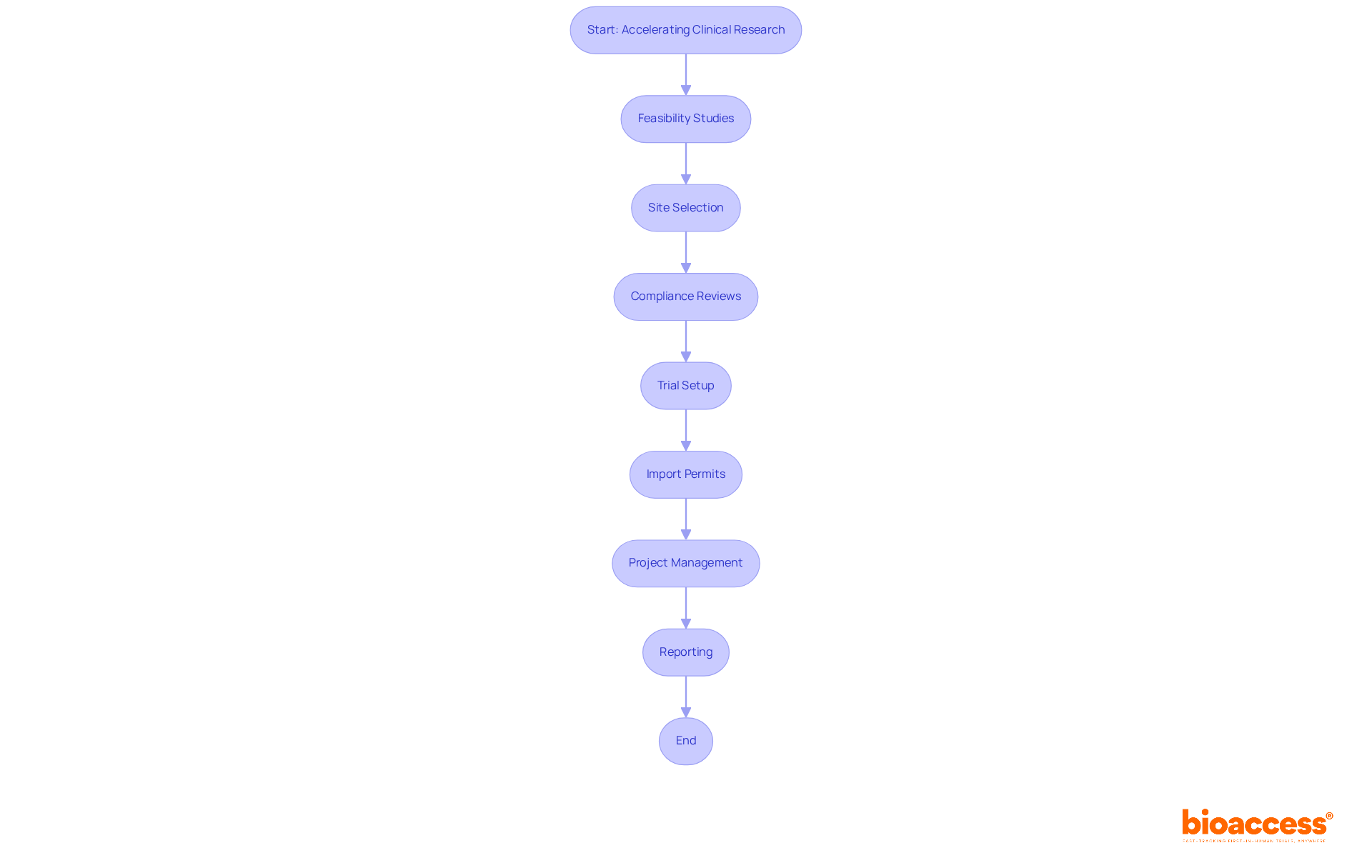
Actinium-225 (Ac-225) stands out as a highly effective alpha-emitting radionuclide, emerging as a pivotal agent in targeted alpha therapies. Its unique capability to deliver high-energy radiation directly to cancer cells, while sparing surrounding healthy tissues, positions it as a valuable asset in oncology. Recent studies have demonstrated Ac-225's efficacy in treating various malignancies, notably metastatic castration-resistant prostate cancer (mCRPC) and acute myeloid leukemia, with significant tumor regression observed in clinical trials.
For instance, a meta-analysis revealed that:
The isotope's half-life of 10 days enables effective dosing schedules, improving its clinical relevance in targeted treatments. Furthermore, the stability of Ac-225 constructs in serum has been confirmed, with studies showing that [Ac]DOTA-HuM195 maintained over 95% binding in serum over 15 days, ensuring effective targeting and retention within cancer cells.
This stability, coupled with its high linear energy transfer, enables localized effects that reduce systemic toxicity, positioning Ac-225 as a promising candidate for enhancing cancer care protocols. However, managing the distribution and clearance of Ac-225 progeny presents challenges that must be addressed to optimize therapeutic outcomes. Furthermore, typical negative occurrences linked with Ac-PSMA intervention, like xerostomia noted in 63% of individuals, underscore the significance of overseeing patient safety while utilizing the method's effectiveness.
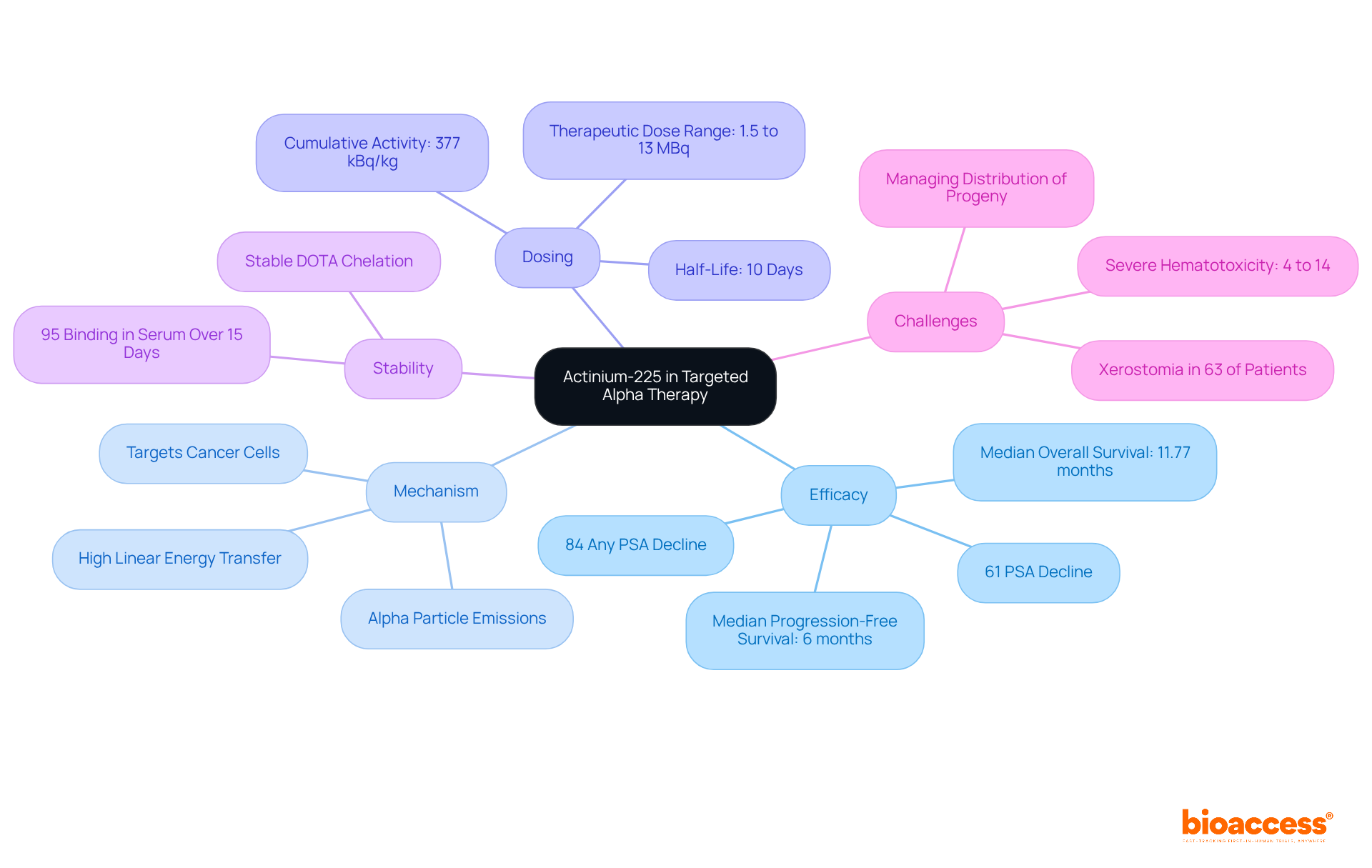
Bismuth-213 (Bi-213) plays a crucial role in targeted alpha therapies, especially when combined with actinium-225 (Ac-225). Its short half-life of approximately 46 minutes facilitates the rapid administration of therapeutic doses, making it especially effective for aggressive cancers. Recent studies have demonstrated that Bi-213, when utilized alongside monoclonal antibodies or peptides aimed at specific tumor antigens, significantly enhances precision in therapy. This targeted methodology not only boosts therapeutic efficacy but also minimizes systemic toxicity, positioning Bi-213 as an essential component in the fight against cancer.
Clinical trials have yielded promising results, with Bi-213 conjugated to monoclonal antibodies resulting in substantial tumor regression and improved patient outcomes. Notably, targeted radiation treatment (TAT) achieved an objective response rate (ORR) of 49.5% and a disease control rate (DCR) of 87.0%, underscoring its efficacy. Furthermore, the incidence of serious hematologic and renal toxicities was low, recorded at 2.1% and 3.4%, respectively, indicating a favorable safety profile. The integration of Bi-213 in treatment regimens exemplifies a forward-thinking approach in oncology, effectively leveraging its unique properties to combat resistant cancer types.
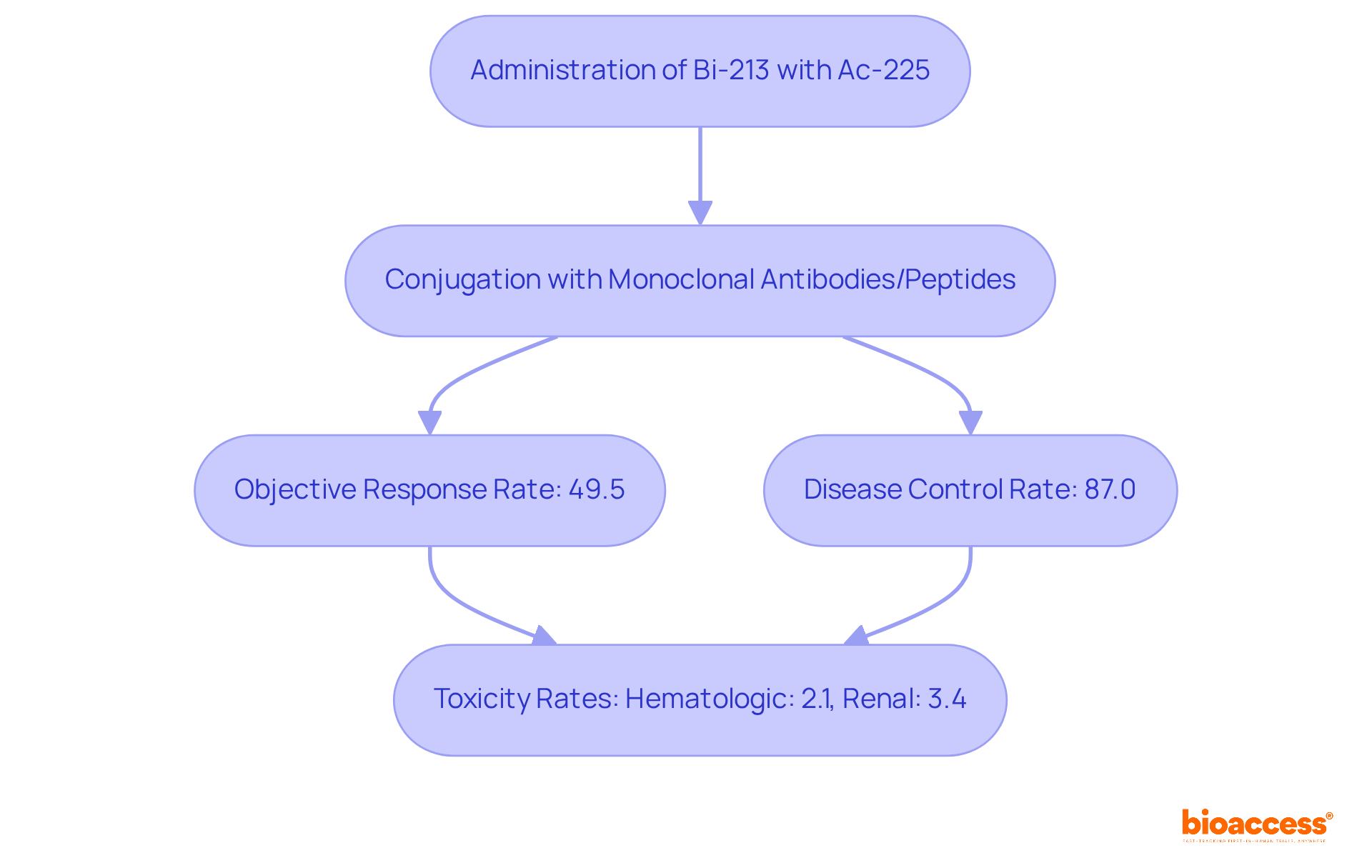
Lead-212 (Pb-212) is emerging as a pivotal element in targeted alpha therapies, largely due to its advantageous decay characteristics and capacity to deliver potent alpha radiation directly to tumors. With a half-life of 10.64 hours, Pb-212 is exceptionally suited for therapeutic protocols that require sustained radiation exposure. Its integration into peptide receptor radionuclide treatment (PRRT) has shown promising results, particularly for patients with neuroendocrine tumors (NETs).
In the ALPHAMEDIX-02 Phase 2 clinical trial, Pb-212 achieved an impressive 34.6% objective response rate and a 96.2% disease control rate among patients who had previously undergone other therapies. Secondary endpoints revealed enhancements in progression-free survival (PFS) and overall survival (OS) for both PRRT-naïve and PRRT-exposed groups.
The selective targeting capability of Pb-212 in targeted alpha therapies not only enhances therapeutic efficacy but also minimizes collateral damage to healthy tissues, positioning it as a promising option in oncology. The FDA granted AlphaMedix Breakthrough Therapy Designation in February 2024, highlighting its potential to advance treatment protocols for unresectable or metastatic SSTR-positive GEP-NETs, thus paving the way for improved patient outcomes. Furthermore, the safety profile of AlphaMedix remained consistent and manageable across both patient cohorts, offering a balanced perspective on its efficacy and safety.

Creative manufacturing methods for isotopes that emit particles are crucial for the advancement of targeted treatments in clinical research. Recent developments in accelerator technology and generator systems have significantly improved the yield and purity of isotopes such as Ac-225 and Bi-213. These advancements not only enhance the availability of these essential radionuclides but also reduce production expenses, thereby making targeted alpha therapies more accessible for clinical trials and eventual commercialization. Continuous research into optimizing production methods is vital for meeting the growing demand for effective cancer treatments.

Targeted alpha therapies are a cutting-edge approach that operates by emitting high-energy particles, which induce double-strand breaks (DSBs) in the DNA of tumor cells, ultimately leading to cell death. The limited range of targeted alpha therapies—typically spanning just a few cell diameters—allows for precise targeting of malignant cells while minimizing damage to surrounding healthy tissue. This specificity is crucial for enhancing therapeutic efficacy.
Moreover, TAT can trigger bystander effects, where non-targeted cancer cells suffer radiation-induced damage due to signals from irradiated neighboring cells. Research indicates that these bystander effects can significantly amplify the overall therapeutic impact of targeted alpha therapies, particularly at low doses of 0.5 Gy, establishing it as a compelling strategy for addressing various malignancies.
The interplay between direct DNA damage and bystander signaling pathways not only enhances the effectiveness of targeted alpha therapies but also highlights their potential in contemporary cancer care paradigms. Additionally, the contribution of targeted effects increases with dose and becomes predominant at high doses, emphasizing the importance of dose management in treatment strategies.
The systemic nature of radiation effects, including the abscopal phenomenon, further emphasizes the broader implications of targeted alpha therapies in cancer treatment. It is also noteworthy that the adverse effects of radiation are associated with the induction of a high percentage of clustered lesions, which presents potential risks linked to TAT.
As Jean-Pierre Pouget noted, targeted alpha therapies are particularly indicated for very small-volume, disseminated tumors, showcasing their clinical relevance.
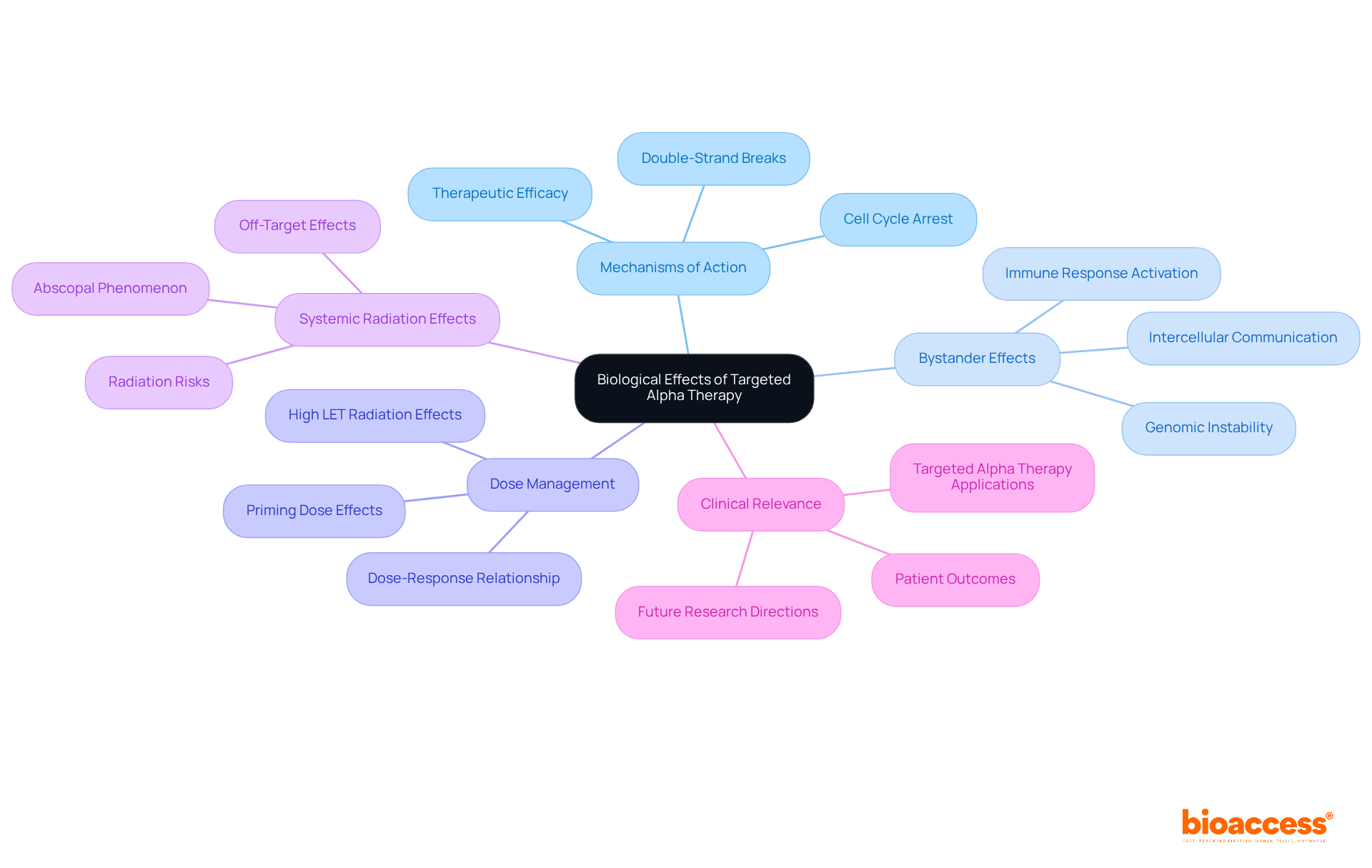
The safety and tolerability of targeted alpha therapies remain a pivotal focus in clinical trials, underscoring their relevance in clinical research. TAT is generally associated with a favorable safety profile, primarily due to the localized nature of radiation. Common side effects, such as:
are often observed; however, severe adverse events are relatively rare. Ongoing studies are crucial, as they continuously monitor the long-term safety of targeted alpha therapies, ensuring that any potential risks are meticulously evaluated and managed. This unwavering emphasis on patient safety is paramount in the advancement of new alpha-emitting radionuclides and their clinical applications.
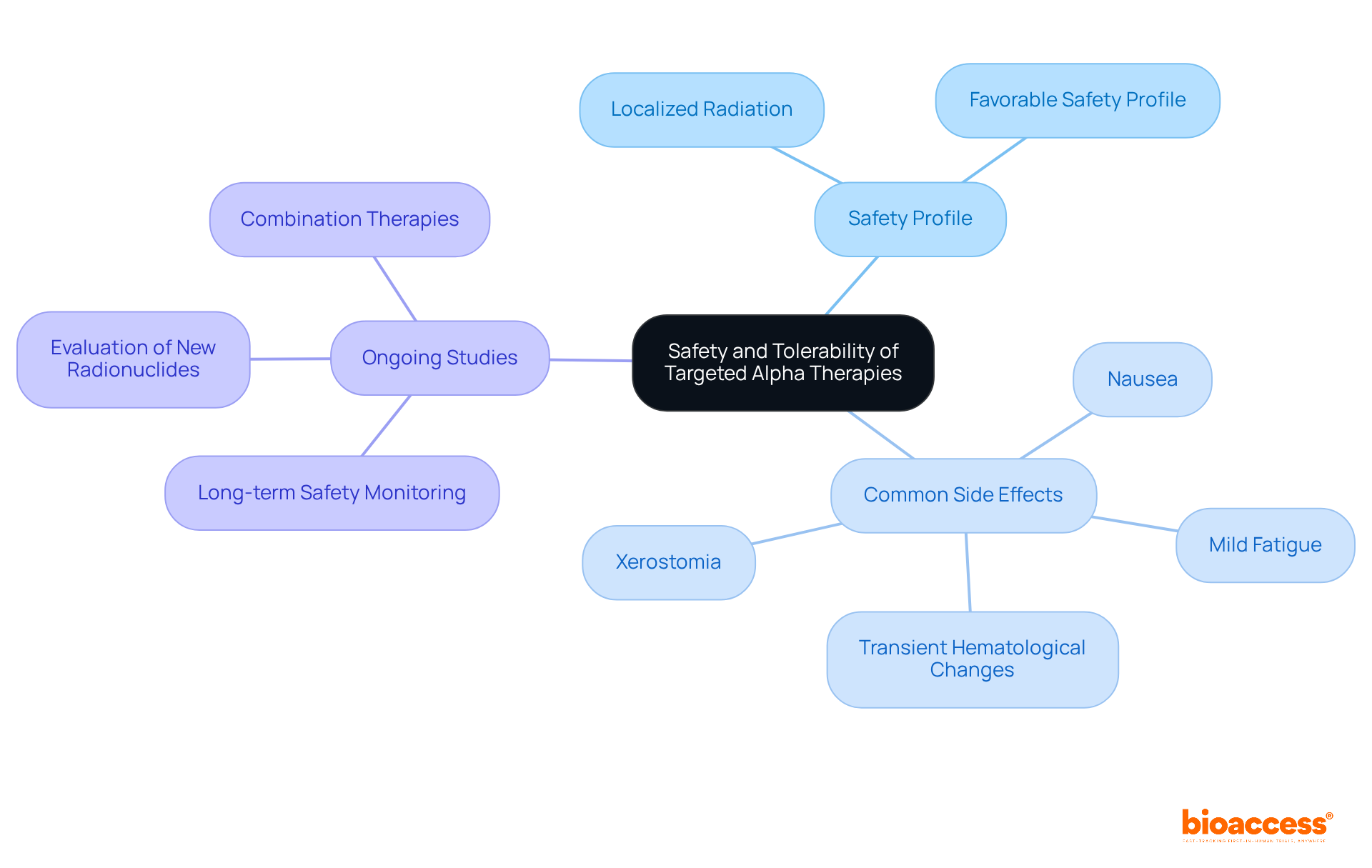
Targeted alpha therapies have emerged as a promising approach for various cancers, including prostate cancer, neuroendocrine tumors, and acute myeloid leukemia. By delivering localized radiation directly to tumor cells, TAT effectively targets both primary and metastatic lesions, minimizing damage to surrounding healthy tissues. Recent clinical trials have demonstrated significant effectiveness, with options like 212Pb-DOTAMTATE achieving an impressive 85.1% overall survival rate at 18 months for patients with gastroenteropancreatic neuroendocrine tumors (GEP-NETs). With approximately 35 out of 100,000 individuals globally estimated to be impacted by neuroendocrine tumors, the critical need for effective solutions such as targeted alpha therapies is underscored.
Furthermore, TAT is currently being investigated in conjunction with other therapeutic modalities, such as immunotherapy and chemotherapy, to enhance outcomes. For instance, the combination of 177Lu-DOTATATE and olaparib has shown both feasibility and safety, paving the way for larger studies. The FDA's approval of Radium-223 for advanced prostate cancer highlights the clinical relevance of TAT in this area. The flexibility of targeted alpha therapies positions them as a significant option in the evolving field of oncology, addressing essential unmet needs in managing cancers resistant to conventional treatments.
With over 20 targeted alpha therapies in clinical trials globally and $10 billion invested by pharmaceutical firms in radiopharmaceuticals, the future of TAT appears promising, potentially transforming cancer care paradigms. The disease control rate for 212Pb-DOTAMTATE was reported at 96.2%, further emphasizing its efficacy in clinical settings. Given that the typical five-year survival rate for metastatic neuroendocrine tumors is 60%, TAT represents a substantial improvement in care options.
Additionally, the typical course of treatment for Lutathera and Pluvicto ranges from four to five doses, with Lutathera costing $35,000 per dose and Pluvicto costing $27,000 per dose. Integrating insights from experts like Dr. François Bénard and Christopher Corsico can further enhance the understanding of TAT's potential in oncology.
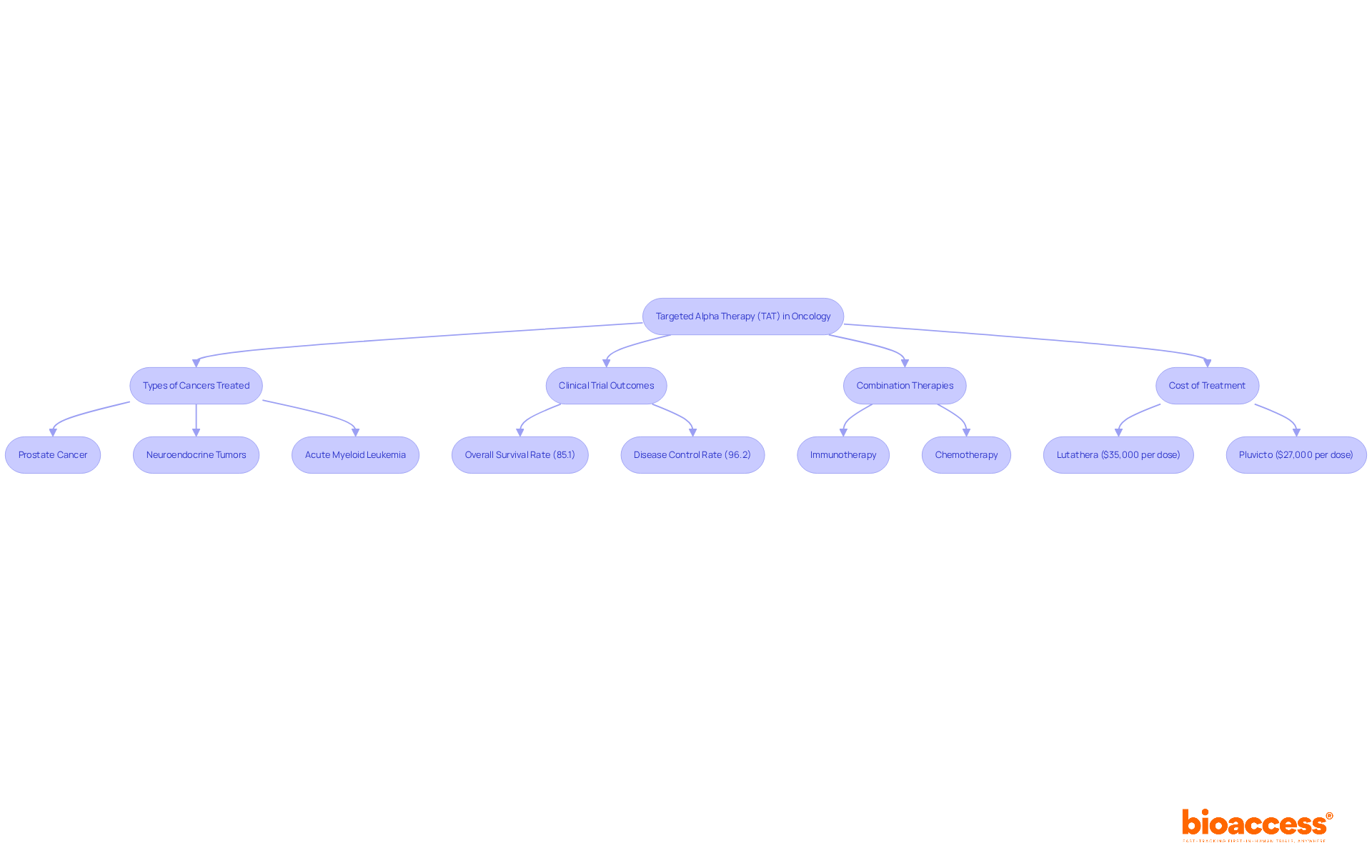
The future of targeted alpha therapies is exceptionally promising, driven by continuous research aimed at optimizing existing isotopes and pioneering new ones. Innovations in radiopharmaceutical design, including improved targeting vectors and the creation of combination treatments, are poised to greatly enhance the effectiveness of targeted alpha therapies. Moreover, advancements in imaging methods are essential for enhancing patient selection and monitoring, ultimately resulting in improved clinical outcomes. As these innovations develop, targeted radiotherapy is set to become a crucial part of precision oncology, effectively addressing the distinct challenges posed by various cancer types.
With the global market for targeted alpha therapies expected to expand from $199.6 million in 2024 to $1.1 billion by 2030, at a compound annual growth rate (CAGR) of 44% from 2025 to 2030, the incorporation of targeted alpha therapies advancements will play a critical role in transforming cancer care paradigms.
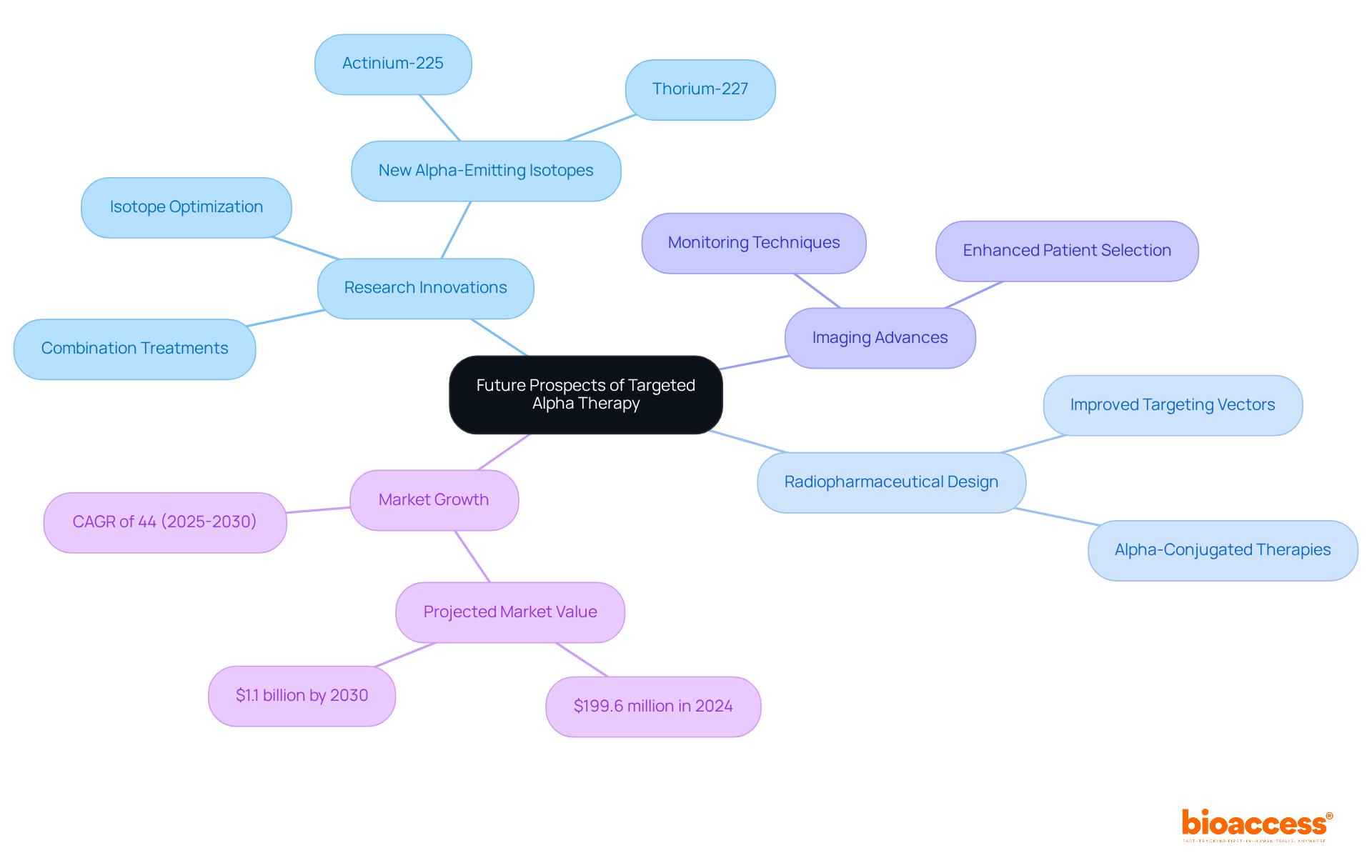
Targeted particle treatment (TAT) presents significant potential for cancer care, yet it encounters critical challenges that must be addressed to gain broader acceptance. A primary concern is the limited availability of alpha-emitting isotopes, particularly actinium-225, which has a half-life of just 10 days. This rarity complicates the production and supply chain, as only a few facilities globally can produce it in research-scale quantities. For instance, CNL's Chalk River Laboratories stands out as one of the few capable of generating pure actinium-225, which is essential for advancing TAT research.
Regulatory hurdles further complicate the landscape. The approval timelines for targeted radiopharmaceuticals can be lengthy, often extending beyond conventional drug development processes. While some radiopharmaceuticals, such as Xofigo, have achieved clinical approval, the path to market for new TAT agents remains fraught with challenges, including high costs and long wait times that limit reliable access to TAT radionuclides for research groups. Collaborative initiatives, such as the PRISMAP project funded by the EU's Horizon 2020 program, aim to streamline access to radionuclides and facilitate regulatory processes, underscoring the importance of partnerships among researchers, regulatory bodies, and industry stakeholders.
Moreover, ensuring consistent quality and safety in radiopharmaceuticals is paramount. As the market for high-energy emitters is anticipated to expand considerably, reaching an estimated USD 40.1 billion by 2035, the need for efficient regulatory frameworks and production standards grows ever more essential. Addressing these challenges through innovative production strategies and improved targeting methods will be crucial for unlocking the full potential of targeted alpha therapies in clinical practice.

Targeted alpha therapies represent a groundbreaking approach in oncology, offering innovative solutions for effectively treating various cancers. By harnessing the unique properties of alpha-emitting isotopes, such as Actinium-225, Bismuth-213, and Lead-212, these therapies provide precise targeting of tumor cells while minimizing damage to surrounding healthy tissues. The advancements in clinical research, particularly through platforms like bioaccess®, have streamlined the development and implementation of these therapies, significantly enhancing patient outcomes.
The article highlights several key insights, including:
Moreover, the focus on innovative production techniques and the ongoing commitment to patient safety further underscore the potential of targeted alpha therapies to transform cancer treatment paradigms. With the anticipated growth of this market and the emergence of new research, the future of targeted alpha therapies looks exceptionally bright.
As the landscape of cancer treatment continues to evolve, the importance of targeted alpha therapies cannot be overstated. Stakeholders in the medical and research communities are encouraged to collaborate and innovate, overcoming challenges related to isotope availability and regulatory hurdles. By doing so, the promise of targeted alpha therapies can be fully realized, ultimately leading to improved therapeutic options and enhanced quality of life for patients battling cancer.
What is bioaccess® and what does it specialize in?
bioaccess® specializes in accelerating clinical research for targeted alpha therapies by navigating regulatory landscapes in regions such as Latin America, the Balkans, and Australia.
How quickly can bioaccess® secure ethical approvals?
bioaccess® can secure ethical approvals in just 4-6 weeks.
How does bioaccess® improve the enrollment process for clinical trials?
The enrollment processes managed by bioaccess® are 50% faster than those in traditional markets.
What steps are included in bioaccess®'s comprehensive clinical trial process?
The comprehensive process includes feasibility studies, site selection, compliance reviews, trial setup, import permits, project management, and reporting.
Why is timely clinical information important in targeted alpha therapies?
Timely clinical information can significantly influence treatment outcomes and improve market positioning in the evolving field of targeted alpha therapies.
What challenges does the clinical development industry currently face?
The industry is facing declining success rates in clinical development, increased competition, and rising attrition rates.
What is Actinium-225 and its role in targeted alpha therapy?
Actinium-225 (Ac-225) is a highly effective alpha-emitting radionuclide used in targeted alpha therapies, known for delivering high-energy radiation directly to cancer cells while sparing healthy tissues.
What are some clinical outcomes associated with Ac-225 treatment?
Clinical studies have shown that approximately 61% of patients experienced more than a 50% decline in prostate-specific antigen (PSA) levels, and 84% showed any PSA decline.
What is the half-life of Actinium-225 and why is it significant?
The half-life of Actinium-225 is 10 days, which allows for effective dosing schedules in targeted treatments.
What challenges are associated with the use of Ac-225?
Challenges include managing the distribution and clearance of Ac-225 progeny and overseeing patient safety, particularly concerning side effects like xerostomia.
What is the significance of Bismuth-213 in targeted alpha therapy?
Bismuth-213 (Bi-213) enhances the efficacy of targeted alpha therapies, especially when used in combination with Ac-225, due to its short half-life and ability to improve precision in targeting tumors.
What are the clinical results related to Bi-213 in treatment regimens?
Clinical trials have shown that Bi-213 conjugated to monoclonal antibodies results in substantial tumor regression, with an objective response rate (ORR) of 49.5% and a disease control rate (DCR) of 87.0%.
What is the safety profile of Bi-213 in clinical trials?
The incidence of serious hematologic and renal toxicities associated with Bi-213 treatment was low, recorded at 2.1% and 3.4%, respectively, indicating a favorable safety profile.